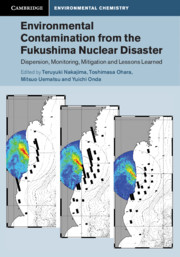 Environmental Contamination from the Fukushima Nuclear Disaster
Environmental Contamination from the Fukushima Nuclear Disaster Book contents
- Environmental Contamination from the Fukushima Nuclear Disaster
- Cambridge Environmental Chemistry Series
- Environmental Contamination from the Fukushima Nuclear Disaster
- Copyright page
- Contents
- Contributors
- Preface
- Acknowledgements
- Part I Transport of Radioactive Materials in the Environment
- 1 Introduction
- 2 Estimation of Environmental Releases of Radioactive Materials
- 3 Diffusion in the Atmosphere
- 4 Global Transport of Radioactive Materials
- 5 Ocean Transport of Radioactive Materials
- 6 Diffusion and Deposition of Radioactive Materials in the Terrestrial Environment
- Part II Development and Future Issues for the Infrastructure of Disaster Prevention
- Part III Lessons and Future Issues from the Fukushima Accident
- Glossary
- Names of Locations
- Index
- References
5 - Ocean Transport of Radioactive Materials
from Part I - Transport of Radioactive Materials in the Environment
Published online by Cambridge University Press: 16 August 2019
- Environmental Contamination from the Fukushima Nuclear Disaster
- Cambridge Environmental Chemistry Series
- Environmental Contamination from the Fukushima Nuclear Disaster
- Copyright page
- Contents
- Contributors
- Preface
- Acknowledgements
- Part I Transport of Radioactive Materials in the Environment
- 1 Introduction
- 2 Estimation of Environmental Releases of Radioactive Materials
- 3 Diffusion in the Atmosphere
- 4 Global Transport of Radioactive Materials
- 5 Ocean Transport of Radioactive Materials
- 6 Diffusion and Deposition of Radioactive Materials in the Terrestrial Environment
- Part II Development and Future Issues for the Infrastructure of Disaster Prevention
- Part III Lessons and Future Issues from the Fukushima Accident
- Glossary
- Names of Locations
- Index
- References
Summary
Radioactive substances were released from the TEPCO Fukushima Daiichi Nuclear Power Station (FDNPS) accident into the environment, beginning on 11 March 2011. A large amount of radioactive material was released into the atmosphere from the three damaged cores and 80% of it was deposited into the ocean. Radioactive materials also discharged directly into the ocean as leaked stagnant water from the reactor housing. River runoff and groundwater discharge can also be considered as minor sources of the FDNPS-derived radioactivity in the ocean.
- Type
- Chapter
- Information
- Environmental Contamination from the Fukushima Nuclear DisasterDispersion, Monitoring, Mitigation and Lessons Learned, pp. 128 - 166Publisher: Cambridge University PressPrint publication year: 2019


